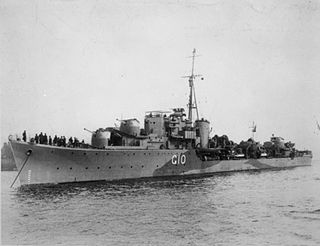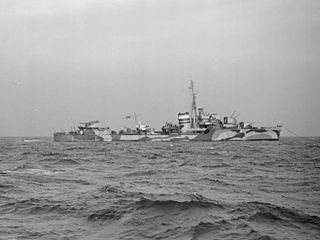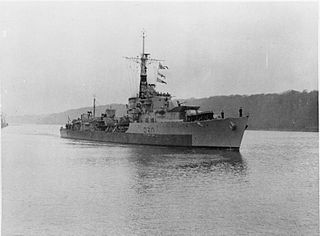
The C class was a class of 32 destroyers of the Royal Navy that were launched from 1943 to 1945. The class was built in four flotillas of 8 vessels, the "Ca", "Ch", "Co" and "Cr" groups or sub-classes, ordered as the 11th, 12th, 13th and 14th Emergency Flotillas respectively. The sub-class names are derived from the initial 2 letters of the member ships' names, although the "Ca" class were originally ordered with a heterogeneous mix of traditional destroyer names. A fifth flotilla, the "Ce" or 15th Emergency Flotilla, was planned but were cancelled in favour of the Weapon-class destroyers after only the first two ships had been ordered. The pennant numbers were all altered from "R" superior to "D" superior at the close of World War II; this involved some renumbering to avoid duplications.

ORP Piorun was an N-class destroyer operated by the Polish Navy in World War II. The word piorun is Polish for "Thunderbolt". Ordered by the Royal Navy in 1939, the ship was laid down as HMS Nerissa before being loaned to the Poles in October 1940 while still under construction.

HMS Penn was a P-class destroyer built for the Royal Navy during the Second World War.

HMS Nubian was a Tribal-class destroyer of the Royal Navy that saw much distinguished service in World War II. She won 13 battle honours, a record only exceeded by one other ship, and matched by two others.

HMS Bedouin was a Tribal-class destroyer of the British Royal Navy that saw service in World War II.

HMS Highlander was an H-class destroyer that had originally been ordered by the Brazilian Navy with the name Jaguaribe in the late 1930s, but was bought by the Royal Navy after the beginning of World War II in September 1939 and later renamed. When completed in March 1940, she was assigned to the 9th Destroyer Flotilla of the Home Fleet. The ship was assigned to convoy escort duties in June with the Western Approaches Command, sinking one German submarine in October. Highlander was transferred to Freetown, Sierra Leone, in mid-1941 to escort convoys off West Africa, but returned to the United Kingdom in August. She became flotilla leader of Escort Group B-4 of the Mid-Ocean Escort Force in early 1942 and continued to escort convoys in the North Atlantic for the rest of the war. The ship became a target ship after the war ended and was sold for scrap in mid-1946.

HMS Pathfinder was a P-class destroyer built for the Royal Navy during the Second World War. She was damaged while serving in the Far East, and was scrapped after the end of the war.

HMS Wolfhound was one of 21 W-class destroyers built for the Royal Navy during the First World War. Completed in 1918 the ship only played a minor role in the war before its end. The ship was converted into an anti-aircraft escort destroyer during the Second World War and was badly damaged during the Dunkirk evacuation. Wolfhound survived the war and was sold for scrap in 1948.

HMS Milne was a M-class destroyer of the Royal Navy which served during World War II. She was equipped as a flotilla leader.

HMS Consort was one of thirty-two C-class destroyers built for the Royal Navy during the Second World War, a member of the eight-ship Co sub-class.

HMS Loyal was a L-class destroyer built for the Royal Navy in the late 1930s, although she was not completed until after World War II had begun.

The fifth HMS Valorous, ex-HMS Montrose, was a V-class flotilla leader of the British Royal Navy that saw service in World War I, the Russian Civil War, and World War II.

The second HMS Vanity was a V-class destroyer built for the Royal Navy during World War I that saw service in World War II.

HMS Carron was one of thirty-two C-class destroyers built for the Royal Navy during the Second World War, a member of the eight-ship Ca sub-class. Commissioned in late 1944, she was assigned to the Home Fleet and escorted the fleet's larger ships during operations off German-occupied Norway. Carron was sold for scrap in 1967.

HMS Cambrian was one of eight C-class destroyers built for the Royal Navy during the Second World War. commissioned in mid-1944, she was assigned to the Home Fleet and escorted two Arctic convoys as well as larger elements of the fleet during operations off the German-occupied Norwegian coast.

HMS Caesar was one of thirty-two C-class destroyers built for the Royal Navy during the Second World War, a member of the eight-ship Ca sub-class. Commissioned in 1944, she was built as a flotilla leader with additional accommodation for staff officers. The ship was assigned to Home Fleet during 1944–1945 and escorted one Arctic convoy as well as the capital ships of the fleet.

HMS Cheviot was one of thirty-two C-class destroyers built for the Royal Navy during the Second World War, a member of the eight-ship Ch sub-class. Completed after the war, she was sold for scrap in 1962.

HMS Childers was one of thirty-two C-class destroyers built for the Royal Navy during the Second World War, a member of the eight-ship Ch sub-class. Commissioned in 1945, she was built as a flotilla leader with additional accommodation for staff officers.

HMS Chivalrous was one of thirty-two C-class destroyers built for the Royal Navy during the Second World War, a member of the eight-ship Ch sub-class. Commissioned in 1946, she was built as a flotilla leader with additional accommodation for staff officers. The ship was loaned to the Pakistani Navy during the late 1950s and was sold for scrap in 1961 after being returned.

HMS Comet was one of thirty-two C-class destroyers built for the Royal Navy during the Second World War, a member of the eight-ship Co sub-class.





















